mobile View, to the German Version tap the flag


- Autonomous Region of Spain
- 13th to 15th century Kingdom of Castile-Leon
- own name:
– Spanish: Castilla y León
• Flag
• Historical and other Flags
• Meaning/Origin of the Flag
• Coat of Arms
• Historical Coats of Arms
• Meaning/Origin of the Coat of Arms
• Map of the autonomous regions of Spain
• Map of the historical Kingdoms on the Iberian Peninsula
• Numbers and Facts
• History
• Origin of the Country's Name
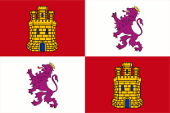
since 1980,
Flag of Castile-Leon,
ratio = 2:3,
Source, by: Flags of the World






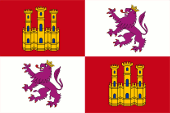
1230–1479,
Flag of the Kingdom of Castile-Leon,
Source, by: Wikipedia (DE)





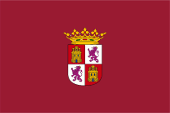
1978–1980,
Flag of Castile-Leon,
Source, by: Wikipedia (DE)




The current flag of the Spanish autonomous community of Castile and Leon was introduced by law on 25 of February in 1983. It shows the design of the flag of the old kingdom of Castile-Leon, which existed until 1479. The flag of the old kingdom of Castile-Leon was, as was customary at the time, a flag of arms. That is, a flag that displayed the image of the coat of arms of the country (actually the ruler). The flag cloth is quartered and shows a combination of the heraldry of Castile and of Leon: castle and lion. This design was created in 1230 by the union of the crowns of the two countries. With the foundation of the Spanish state in 1479, the symbolism of the kingdom of Castile-Leon receded into the background. Of course, over the centuries, the castle and the lion have always appeared in different guises, subject to the taste of the times, because there were no specifications or regulations about the exact design of the images at that time. Today's appearance, however, has been fixed since 1983. However, under the government of General Franco (1936-1975), all regional flags were banned. After Franco's death (1975), regional flags were introduced or reintroduced. In 1978, New Castile (Castile-La Mancha) and Old Castile (Castile-Leon) introduced their own flags, albeit unofficially at first, as neither had autonomous status until 1982/83. The power and culture of Castile-Leon shaped the whole of Spain for centuries. However, especially since the 1970s, all the components of the Spanish state began to reflect on their actual cultural origins and developed autonomy aspirations, which was actually a movement away from the dominant Castile. Thus, in 1978, before the current model, a different flag was initially introduced. It went back to a 16th century banner, was plain purple and bore the country's coat of arms in the centre. As early as around 1980, Castile-Leon recalled its tradition and reactivated the original symbolism of Castile-Leon from the 15th century. However, the plain purple flag is still considered the country's banner today.
Source:
Wikipedia (DE),
Flags of the World,
Volker Preuß

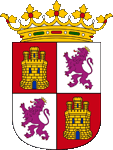
since 1978,
Coat of arms of Castile-Leon,
Source, by: Heralder],
some elements by Rastrojo, CC BY-SA 3.0, via Wikimedia Commons

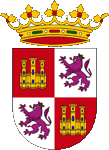
from 13th century,
Coat of arms of the Kingdom of Castile-Leon,
Source, by: Wikipedia (DE), Flags of the World

The current coat of arms of the Spanish autonomous community of Castile and Leon was probably reintroduced for the region in 1978 and confirmed by law on 25th of February in 1983, when the autonomous community was founded. It shows the design of the coat of arms of the old kingdom of Castile-Leon, which existed until 1479. It was quartered and showed a combination of the heraldry of Castile and Leon: castle and lion. This design was created in 1230 by the union of the crowns of the two countries. Of course, over the centuries, the castle and the lion have always appeared in different guises, subject to the taste of the times, because there were no specifications or regulations about the exact design of the images at that time. Today's appearance, however, has been fixed since 1983.
Source:
Wikipedia (ES),
Volker Preuß

The autonomous Regions of Spain:
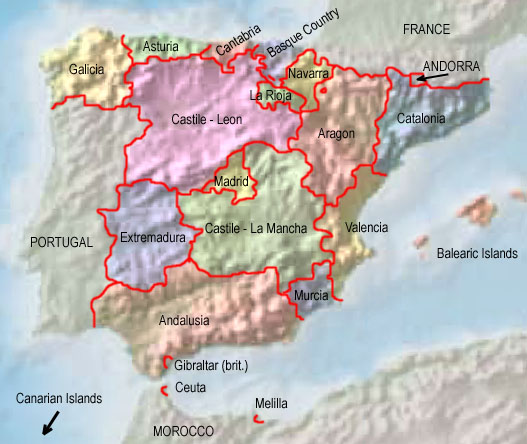
Source: Freeware, University of Texas Libraries, modyfied by: Volker Preuß

Map of the historical Kingdoms on the Iberian Peninsula (ca. 1220):
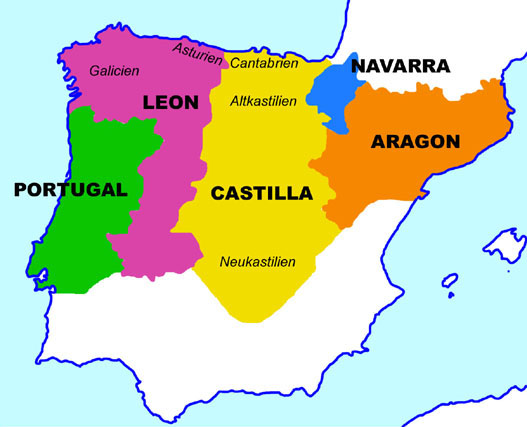
Map: Volker Preuß

Area: 36.380 square miles
Inhabitants: 2.372.495 (2022), mostly Castilians, also Leonese
Density of Population: 65 inh./sq.mi.
Capital: Valladolid, 295.639 inh. (2022)
official Language: Spanish (Castilian)
other Languages: Leonese
Currency: Spanish (Euro) currency
Time Zone: GMT + 1 h
Source: Wikipedia (DE)

The Kingdom of Castile-Leon came into being by unification of the crowns of the both Kingdoms Castile (← click here) and Leon (← click here) in the year 1230. Castile became to the most important and main component of the Kingdom of Castile-Leon.
1230–1252 · reign of King Ferdinand III. (the Saint), very successful battles in the liberation war against the Arabs, expansion of Castile-Leon to the southern coast of Spain at Atlantic Ocean and Mediterranean Sea
1236 · liberation of Córdoba from the Arabs, establishment of the Castilian Kingdom of Córdoba
1243 · Murcia Town becomes liberated from the Arabs by Alfons X. of Castile and his troops, establishment of the Castilian Kingdom od Murcia
1248 · liberation of Sevilla from the Arabs, establishment of the Castilian Kingdom of Sevilla
1248 · liberation of Cartagena from the Arabs
1252–1284 · reign of King Alfons X. (the Wise), he is a son of Ferdinand III., throne succession quarrels between his sons Ferdinand (first-born) and Sancho (second-born)
1284–1295 · reign of King Sancho IV. (son of Alfons X.), nobility revolts
1295–1312 · reign of King Ferdinand IV. (son of Sancho IV.), nobility revolts, attacks of the neighbouring kingdoms, the regent Maria de Molina (mother of the infant Ferdinand IV.) is able to preserve Castile-Leon
1312–1350 · reign of King Alfons XI. (son of Ferdinand IV.), nobility revolts, struggles for power, attacks of the neighbouring kingdoms, civil war
1344 · liberation of Algeziras from the Arabs
1350–1369 · reign of King Peter the Cruel (son of Alfons XI.), sinister rule full of cruelty and atrocities, revolts, revolt of his half-brother Henry of Trastamara
1369 · Battle of Montiel, King Peter becomes killed by Henry
1369–1379 · reign of King Henry II. (half-brother of Peter the Cruel), throne quarrels with Peters son-in-law Johann of Lancaster
1379–1390 · reign of King Johann I. (son of Henry II.), war against Portugal and the English dynasty of Lancaster
1387 · Treaty of Bayonne, peace with England
1389 · peace with Portugal
1390–1406 · reign of King Henry III. (son of Johann I.), because of his infancy initially under a regent, from there problems in the administration of the empire
1393 · King Henry III. declares hiself the majority age, marriage with Catharine of Lancaster
1402 · appropriation of the Canary Islands by Castile-Leon
1406–1454 · reign of King Johann II. (son of Henry III.), because of his infancy initially under a regent
1439 · agitations, riotings
1454–1474 · reign of King Henry IV., the Unconscious, (son of Johann II.), succession problems, riotings, nobility revolts
1462 · liberation of Gibraltar from the Arabs
1465 · riotings, nobility revolt, the nobility designates Alfons, the 11 years old brother of Henry IV. to the king, civil war
1468 · death of Alfons, the nobility proclaims Isabella, the sister of Henry IV. to the queen (Isabella I.)
Isabella I. Queen of Castile-Leon marrys Ferdinand II., the Prince and Throne-Successor of Aragon in the year 1469. They both become crowned to the Kings of Spain in 1479 and in this way Castile-Leon and Aragon become united to one country. The mighty and old Castile-Leon becomes in this way to the main component of Spain and becomes shaping for the Spanish culture.
11th of December 1474 · death of Henry IV., end of the civil war, Isabella I. becomes confirmed as heiress of Castile-Leon, Portugal claims the throne, war of Portugal and France against Castile-Leon
1476 · Battle of Toro, defeat of the Portugese
1479 · peace of Alcantara, Portugal recognizes Isabella as queen of Castile-Leon
1479 · death of King Johann II. of Aragon, successor is Ferdinand II., husband of queen Isabella I., unification of the crowns of Aragon and Castile-Leon, coronation of Ferdinand II. and Isabella I. to the Kings of Spain
1492 · conquest of the Emirate of Granada by Spanish troops, in this way elimination of the last bridgehead of the Arabs on European territory, Christoph Columbus discovers America, start of the Spanish colonial era, rise of Spain to the world power
1808–1813 · Kastilien is occupied by French troops
1833 · the until that point in time in Spain existing partial kingdoms and regions become divided in provinces, Old Castile and Leon too, namely in the provinces of León, Zamora, Salamanca, Palencia, Burgos, Logroño, Valladolid, Avila, La Granja and Soria
1936–1939 · Spanish civil war, Old Castile and Leon (the today's Castile-Leon) fights on the side of the troops of General Franco against the socialistic central government, New Castile (the today's Castile-La Mancha) fights partially and until 1939 on the side if the socialistic governmental troops
25th of March 1983 · Castile-Leon gets the statute of autonomy within Spain (by summary of the provinces of León, Zamora, Salamanca, Palencia, Burgos, Valladolid, Avila, La Granja and Soria), establishment of the "Autonomous Community of Castile and Leon"
Source: Wikipedia (ES),
World Statesmen,
RetroBib Retrobibliothek,
Volker Preuß

The name "Castile-Leon" is a combination of the names of the two regions "Castile" and "Leon".
Source: Volker Preuß


![]()














